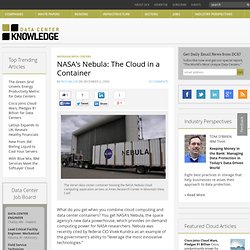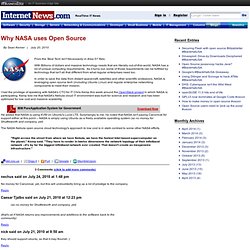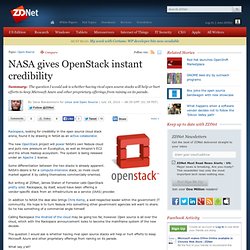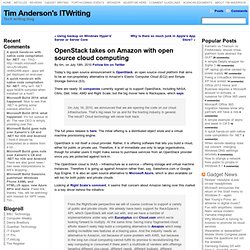

Opera: State of the Mobile Web, Year-End 2010. Opera Software has released its State of the Mobile Web report for November 2010 today, but has also taken the opportunity to look back at the preceding months to summarize trends and statistics related to global mobile Web usage for 2010.

The findings? Mobile Web surfing is way, way up. Opera served 340 billion pages during the first 11 months of the year compared with only 129 billion pages during the same period in 2009. There are now 80 million users on the mobile Web using Opera's Mini browser - a 91.8% increase from last year. OpenStack Plans Next Two Cloud Platform Releases at First Public Design Summit. More than 250+ participants, from over 90 companies in 14 countries participated in OpenStack Design Summit SAN ANTONIO – November 17, 2010 – OpenStack™, an open source cloud project with broad developer and commercial support, completed its first public Design Summit last week, which attracted more than 250 people from 90 companies and 14 countries to plan the next two releases, code-named ‘Bexar’ and ‘Cactus.’
Taking place at the Weston Centre in San Antonio, Texas, the four-day event was hosted by Rackspace® Hosting, a founding member of the open source project. The OpenStack Design Summit featured two separate tracks, one consisting of developer-led sessions to plan the next two code releases, and one for interested users and the partner ecosystem to discuss deployment and commercial opportunities. OpenStack Image Registry and Delivery Service (Glance) in Launchpad. NASA’s Nebula: The Cloud in a Container « Data Center Knowledge.
The Verari data center container housing the NASA Nebula cloud computing application arrives at Ames Research Center in Mountain View, Calif.

What do you get when you combine cloud computing and data center containers? You get NASA’s Nebula, the space agency’s new data powerhouse, which provides on-demand computing power for NASA researchers. Nebula was recently cited by federal CIO Vivek Kundra as an example of the government’s ability to “leverage the most innovative technologies.” The Nebula application lives in a 40-foot container at the NASA Ames Research Center in Mountain View, Calif. The “data center in a box” was built inside a FOREST container from Verari Systems, which is filled with Cisco Systems’ Unified Computing System and servers from Silicon Mechanics. OpenStack « RightScale Blog. Canonical CEO on ARM and OpenStack for Ubuntu Servers: Cloud « Nurturing Innovation with Nebula. I’ve been with NASA for over 25 years and Nebula is by far the most dynamic project I’ve worked on to date.
Truly inspired, Nebula has many lessons to share with others on how a small group can drive innovation within a larger, highly structured organization. I’m glad to be a part of Team Nebula so that can I experience daily the energy that pumps through this project team. Innovation doesn’t always come easily… especially in a large federal government agency. True, rules and regulations are needed to manage behemoth organizations and protect taxpayers, but this always has to be balanced so that creativity and innovation are nurtured, not stifled. The senior NASA managers responsible for the oversight of Nebula understand this key point.
How does Nebula do it? Fortunately, Nebula has become a magnet for IT talent. The use of leading edge communications brings us together as a team. Why NASA uses Open Source - InternetNews:The Blog - Sean Michael Kerner. From the 'Best Tech Isn't Necessarily in Area 51' files: With Billions of dollars and massive technology needs that are literally out-of-this-world, NASA has a lot of unique computing requirements.

As it turns out, some of those requirements can be fulfilled by technology that isn't all that different from what regular enterprises need too. In order to save the data from distant spacecraft, satellites and other scientific endeavors, NASA is leveraging open source tech (including Ubuntu Linux) and regular enterprise networking components to meet their mission. NASA Nebula - Cloud Computing. OpenStack Wants to Be Android of The Cloud. Say hello to OpenStack, an open-source cloud platform, which hopes to compete with several proprietary cloud platforms including those being developed by Microsoft and VMware.

RackSpace is spearheading the project and is donating the code that powers its Cloud Files and Cloud Servers to the OpenStack project. The project is also going to incorporate technology from the Nebula Cloud Platform developed by NASA. Here are the key components of the platform: * a fully distributed object store based on Rackspace Cloud Files. Why OpenStack Matters: Cloud Insiders Weigh In. OpenStack Open Source Cloud Computing Software. NASA gives OpenStack instant credibility. Rackspace, looking for credibility in the open source cloud stack arena, found it by drawing in NASA as an active collaborator.

The new OpenStack project will power NASA's own Nebula cloud and puts new pressure on Eucalyptus, as well as Amazon's EC2 and the whole Hadoop ecosystem. The system is being released under an Apache 2 license. Some differentiation between the two stacks is already apparent. NASA's desire is for a compute-intensive stack, so rivals could market against it by calling themselves commercially-oriented. But writing at ZDNet, James Staten of Forrester calls OpenStack pretty solid. In addition to NASA the deal also brings Chris Kemp, a well-respected leader within the government IT community.
Calling Rackspace the Android of the cloud may be going too far, however. The question I would ask is whether having rival open source stacks will help or hurt efforts to keep Microsoft Azure and other proprietary offerings from raining on its parade. What say y'all? OpenStack takes on Amazon with open source cloud computing. By tim, on July 19th, 2010 Follow tim on Twitter Today’s big open source announcement is OpenStack, an open source cloud platform that aims to be an non-proprietary alternative to Amazon’s Elastic Computer Cloud (EC2) and Simple Storage Service (S3).

There are nearly 30 companies currently signed up to support OpenStack, including NASA, Citrix, Dell, Intel, AMD and Right Scale, but the big mover here is Rackspace, which says: Marten Mickos Talks Red Hat, OpenStack and M&A: Cloud «